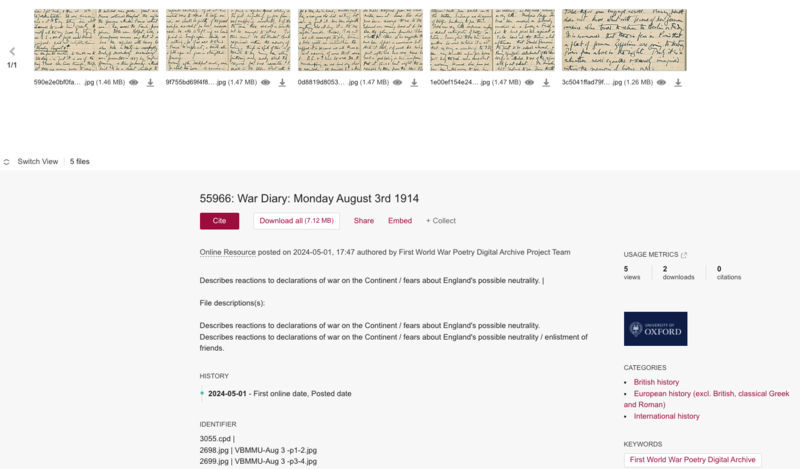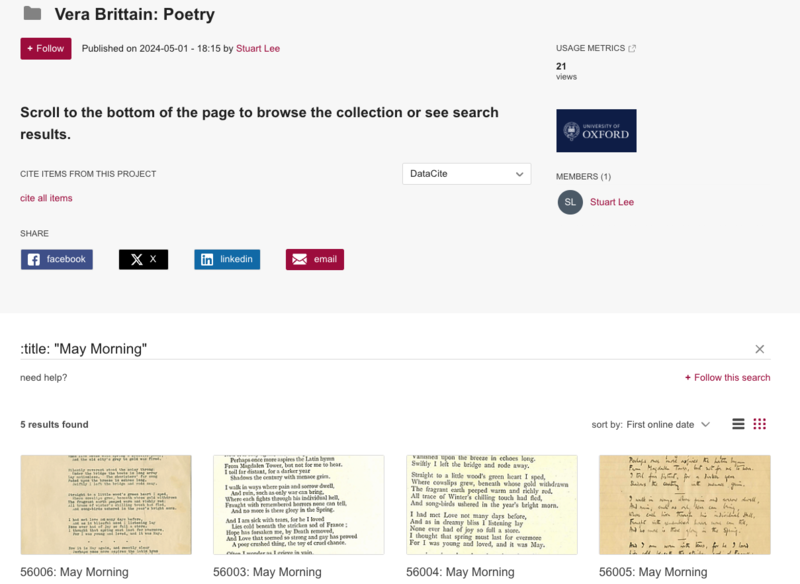Isaac Rosenberg
‘I am determined that this war, with all it's powers for devastation, shall not master my poeting – that is, if I am lucky enough to come through it all right.’
Letter to Laurence Binyon, Autumn 1916
Biography
https://widgets.figshare.com/articles/25739190/embed?show_title=1Isaac Rosenberg (1890 –1918)
Isaac Rosenberg was born in Bristol on 25th November 1890, the son of Barnett and Anna Rosenberg, Lithuanian Jews who had emigrated to Britain a few years before. In 1897, in search of better-paid work, the family moved to the East End of London, but their financial difficulties continued. After a brief period at St Paul’s School, St George’s-in-the-East, Isaac was sent to the Baker Street Board School. Here he exhibited a talent for drawing and writing which his sympathetic headmaster encouraged. He also discovered English poetry, which he read with huge excitement.
By 1904 his family could no longer afford to keep him at school and he was apprenticed to the firm of engravers, Carl Hentschel, in Fleet Street. His earliest known poem dates from 1905. He disliked what he saw as soul-destroying work, and in 1907 began to attend evening classes in painting and drawing at Birkbeck College. In 1911 he was dismissed suddenly from Hentschel’s, but a chance encounter in the National Gallery led to an introduction to a group of wealthy Jewish women. One of these, Mrs Herbert Cohen, offered to support him at art school, and in the autumn of that year he enrolled at the Slade. Among his contemporaries were many of the leading young painters of his day, including Mark Gertler, David Bomberg and Stanley Spencer. 1912 saw the publication of his first slight volume of poems, Night and Day, and in the following year he was introduced to Edward Marsh, the influential patron and editor of the Georgian Poetry series.
Rosenberg hoped to make his living by painting. His work was exhibited in the Whitechapel Gallery, but he found himself increasingly drawn to poetry. In 1914, suffering from a chronic chest infection, he was advised to move to a warmer, dryer climate, and he traveled to South Africa to stay with a married sister. There he continued to write poetry and to paint, and lectures he gave on art were published in a Cape Town journal. He was in South Africa when war was declared; he anticipated its violence in letters to Marsh and in his poem ‘On Receiving News of the War’.
He returned to England in March 1915, and published a second collection of poems entitled Youth. He loathed war and hated the idea of killing, but he was now unemployed and, hearing that his mother would be able to claim a separation allowance, in late October he enlisted. He was initially assigned to the 12th Suffolk Regiment, a Bantam Battalion formed of men less than 5’3’’ in height, but in the spring of 1916 he was transferred to the 11th Battalion, the King’s Own Royal Lancaster Regiment (KORL). In June that year he was sent to France. Shortly before leaving he published his third and final collection of poems, Moses.
Throughout his twenty-one months in the trenches he maintained a correspondence with Edward Marsh, Gordon Bottomley, and Laurence Binyon, all of whom took an interest in his poetry. His trench poems, written on whatever scraps of paper he could find, went through many drafts which he sent home to his sister Annie to be typed and then forwarded to his friends. Despite the difficult conditions under which he worked, he produced remarkable and powerful work, including ‘ August 1914’, ‘Louse Hunting’, ‘Returning, we hear the larks’, ‘Dead Man's Dump’ and ‘Break of Day in the Trenches’. These poems were not published in a single volume until 1922.
Rosenberg was killed early on the morning of 1st April 1918 during the German spring offensive. His body was not immediately found, but in 1926 the remains of eleven soldiers of the KORL were discovered and buried together in Northumberland Cemetery, Fampoux. His body could not be individually identified, but he was known to be among them. This cemetery was later moved, and his remains were reinterred at Bailleul Road East Cemetery, St. Laurent-Blangy, near Arras where his headstone reads ‘Buried near this spot’. Beneath his name, dates and regiment, are engraved the Star of David and the words ‘Artist and Poet’.
| Author | Alisa Miller. Edited by Vivien Noakes |
|---|---|
| Sources |
|
The Isaac Rosenberg Collection
User Guide for the First World War Poetry Digital Archive on Oxford University's SDS Platform
The SDS (Sustainable Digital Scholarship) platform, powered by FigShare, is a robust digital repository used by Oxford University to host a wide range of academic content. It ensures long-term preservation and accessibility of scholarly resources. This user guide will help you navigate the First World War Poetry Digital Archive stored within this platform.
Navigating the Archive
-
Select a Category below: Begin by choosing a category from the available tabs below, such as poetry, correspondence, etc. This selection will link you to specific types of documents within the archive.
-
Accessing Items: Once you click on an item, a new tab will open in your browser directing you to the SDS page containing the selected record. If there are multiple versions of an record, such as a manuscript and a typescript of a poem, the link might direct you to a search result page on SDS where all versions are listed.
-
Example of the page directly to the record:

-
Example of the page when there are multiple versions of a record:

-
-
Browsing Collections: Besides specific searches, you can also browse the entire collections on the SDS platform. This feature allows you to explore additional materials that may not be directly linked to but are part of the First World War Poetry Digital Archive.
Please Note:
- Accessibility: Archive files from recent years are accessible using assistive technologies. Older files, particularly those scanned from original printed volumes, may not be fully accessible and are recommended to be downloaded for optimal viewing.
- Access Restrictions: Some documents, especially those containing sensitive information, are only available to university members through a single sign-on account. Publicly available files can be accessed without such restrictions, adhering to data protection guidelines.
- Assistance Requests: For specific access needs or inquiries, such as obtaining content in accessible formats or accessing restricted files without a single sign-on, please contact the appropriate administrative support via email.
Citing and Downloading Records
- To cite an item, click the 'Cite' button under the item's title in SDS. See below:

- Download Options: You can download files directly from the SDS platform. This is recommended for large files or when a detailed review of documents is required.



